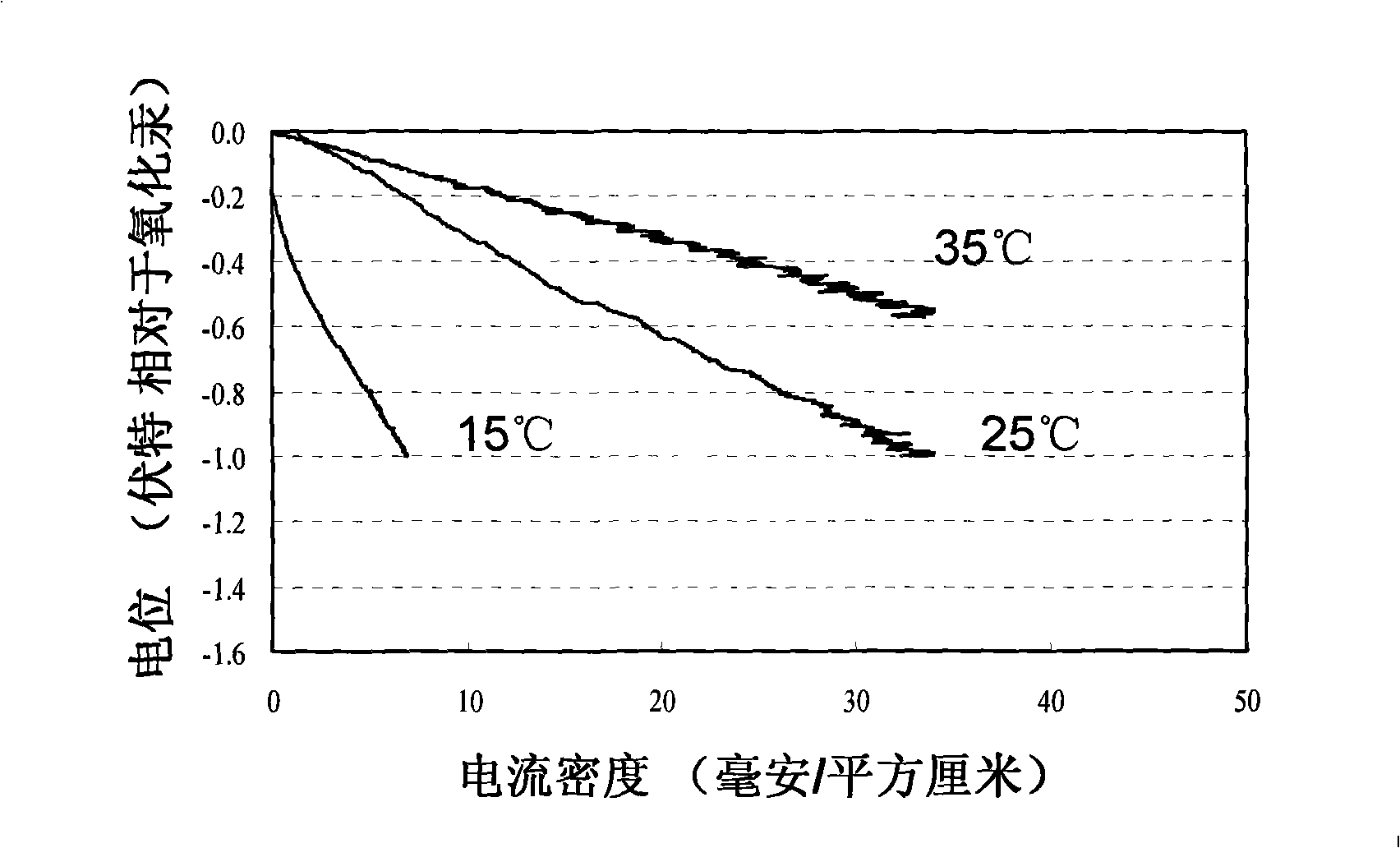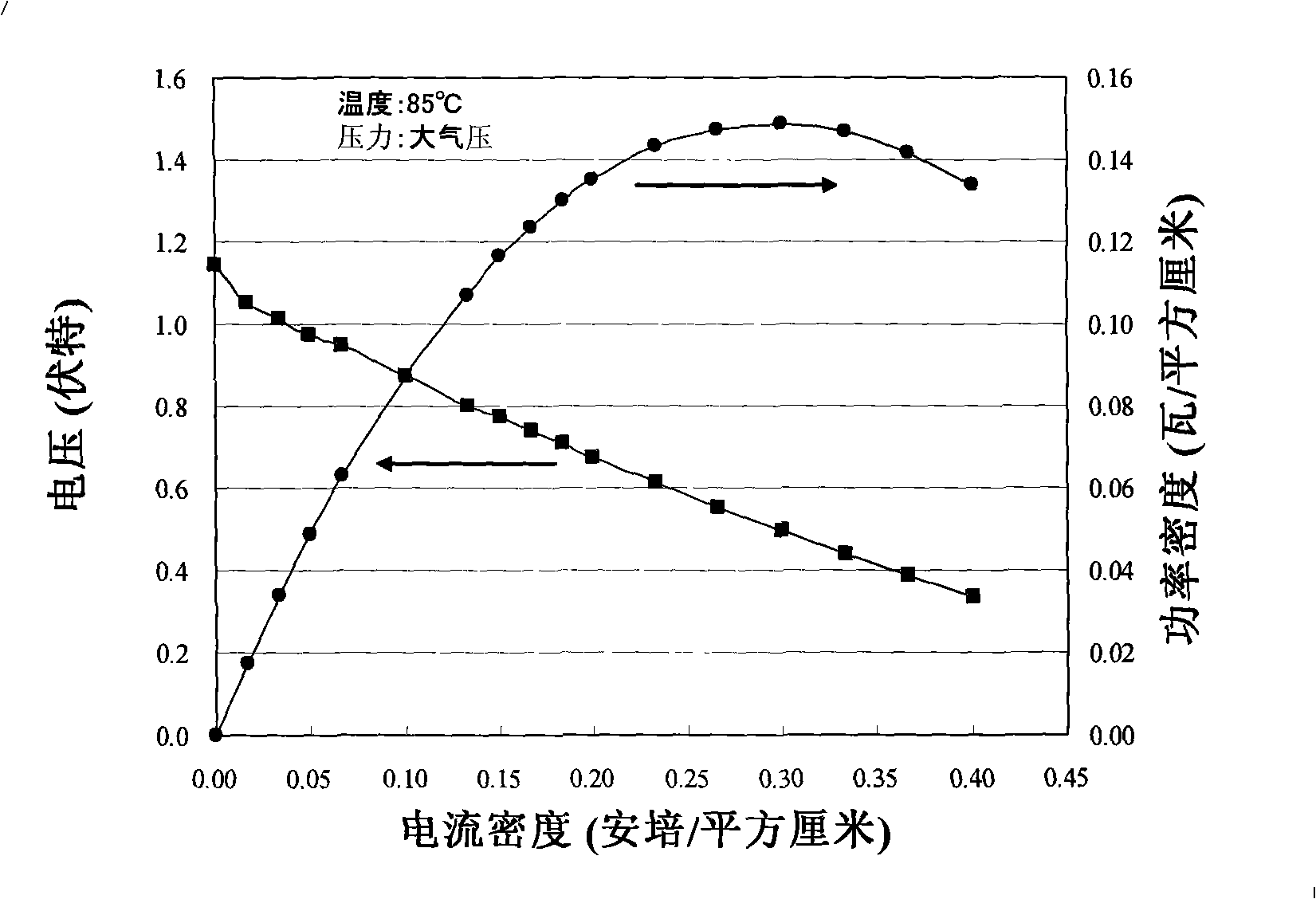Direct sodium borohydride fuel cell using ferrocene as cathode catalyst
A cathode catalyst, fuel cell technology, applied in fuel cells, battery electrodes, circuits, etc., can solve the problems of poor catalyst performance and less research, achieve high electromotive force and energy density, facilitate popularization, and solve the effect of lack of platinum resources
- Summary
- Abstract
- Description
- Claims
- Application Information
AI Technical Summary
Problems solved by technology
Method used
Image
Examples
Embodiment 1
[0033] Use tetrahydrofuran as the solvent to dissolve the ferrocene in the solvent, the mass ratio of the solvent to the ferrocene is 1:0.1, and then add the perfluorosulfonic acid-based resin (Nafion) in the ferrocene solution at the mass ratio of 1:2 The solution is used as a dispersant, and the components of the perfluorosulfonic acid-based resin solution are: Nafion: anhydrous methanol: anhydrous ethanol: water at a ratio of 5:10:5:8 to prepare a ferrocene solution.
[0034] The acetylene black is added to the ferrocene solution, and the mass ratio of the ferrocene solution to the acetylene black is in the range of 1:0.1. After being stirred uniformly by ultrasonic, filtered, washed with distilled water, deionized water or purified water, and dried to obtain a ferrocene-carbon black catalyst.
[0035] The above ferrocene-carbon black catalyst was mixed with Nafion solution and water at a mass ratio of catalyst: Nafion solution: water of 1:5:10, prepared into a slurry, and then...
Embodiment 2
[0037] Example 2: Preparation of ferrocene-cobalt phthalocyanine cathode
[0038] Use cyclohexane as the solvent to dissolve the ferrocene and cobalt phthalocyanine in the solvent. The mass ratio of the solvent to the ferrocene and cobalt phthalocyanine is 1:0.5:0.5, and then press in the ferrocene-cobalt phthalocyanine solution. The mass ratio of 1:4 adds perfluorosulfonic acid-based resin (Nafion) solution as a dispersant. The components of the perfluorosulfonic acid-based resin solution are: Nafion: anhydrous methanol: anhydrous ethanol: water = 10:30:30: 30, thereby preparing a ferrocene-cobalt phthalocyanine solution.
[0039] The acetylene black is added to the ferrocene-cobalt phthalocyanine solution, and the mass ratio of the solution to the carbon black is in the range of 1:5. After being uniformly stirred by ultrasound, it is filtered, washed with distilled water, deionized water or purified water, and dried to obtain a ferrocene-cobalt phthalocyanine-carbon black cataly...
Embodiment 3
[0042] Example 3: Preparation of ferrocene-platinum carbon cathode
[0043] Carbon tetrachloride is used as a solvent to dissolve ferrocene in a solvent, and the mass ratio of the solvent to the ferrocene is 1:2.5 to prepare a ferrocene solution.
[0044] The hydrophobically treated platinum-carbon catalyst (10wt% platinum) is prepared into a slurry with a polytetrafluoroethylene emulsion (10wt%) as a binder at a mass ratio of 1:10, and then applied to the hydrophobically treated After drying on the carbon cloth, calcined in a muffle furnace at 350°C for one hour under a nitrogen atmosphere, and then naturally cooled to room temperature to prepare the cathode matrix. Then it is immersed in the above ferrocene solution and dried to form a hydrophobic ferrocene-platinum carbon cathode.
PUM
 Login to View More
Login to View More Abstract
Description
Claims
Application Information
 Login to View More
Login to View More - R&D
- Intellectual Property
- Life Sciences
- Materials
- Tech Scout
- Unparalleled Data Quality
- Higher Quality Content
- 60% Fewer Hallucinations
Browse by: Latest US Patents, China's latest patents, Technical Efficacy Thesaurus, Application Domain, Technology Topic, Popular Technical Reports.
© 2025 PatSnap. All rights reserved.Legal|Privacy policy|Modern Slavery Act Transparency Statement|Sitemap|About US| Contact US: help@patsnap.com


